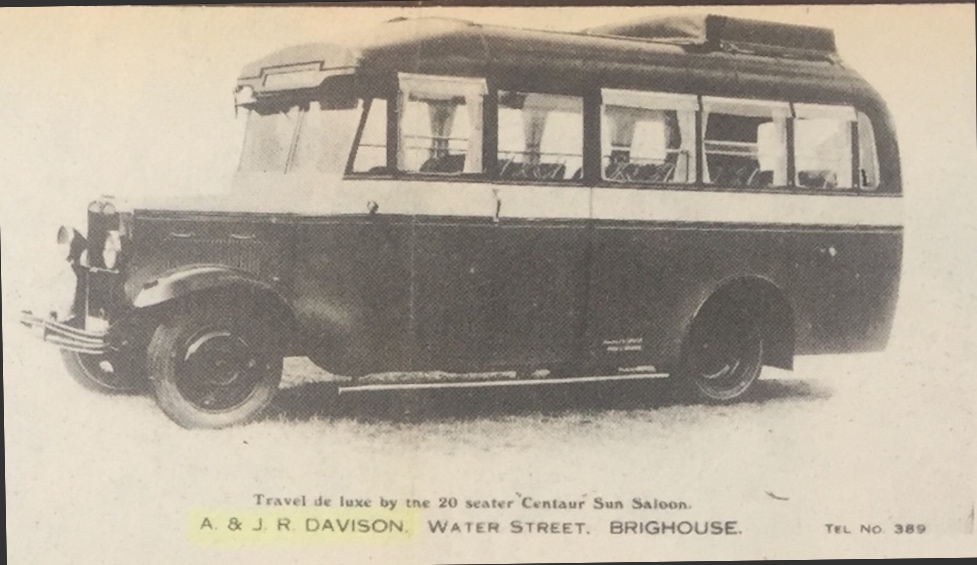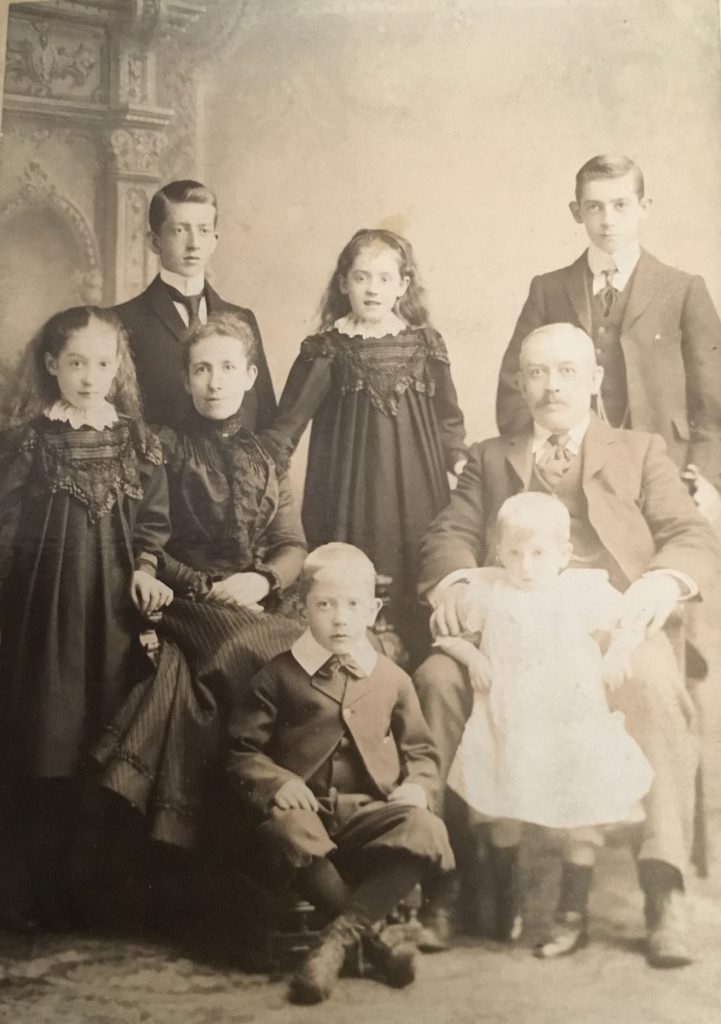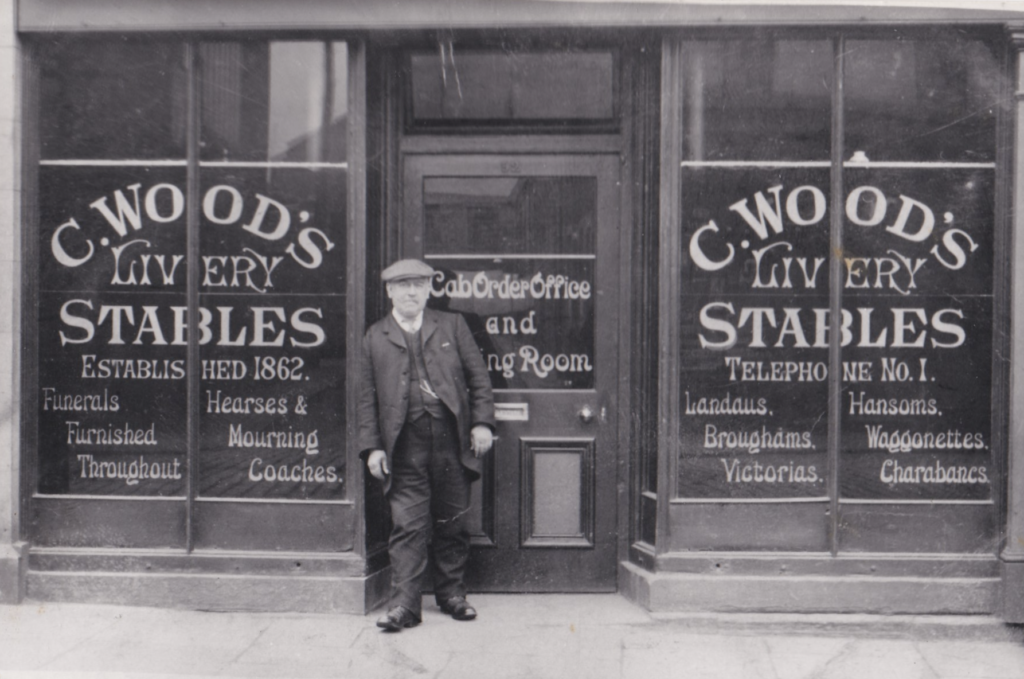CHARLES WOOD
BRIGHOUSE CAB PROPRIETOR
INTRODUCTION
The name of Charles Wood, a former Brighouse taxi cab and funeral company is still spoken about fondly in the area by a decreasing number of the more senior citizens of the town that remember the company when it had gleaming limousines with courteous smart drivers who transported the good people of Brighouse between special functions and their homes.
Though the name still lives on in a local taxi firm and funeral directors, the once gleaming horse drawn cabs and landaus, then latterly motor limousines, are no more. The modern-day taxi takes home customers from local the supermarkets during the day and public houses and clubs by night. What the founder of this once proud business would make of today’s version of the company, one can only guess, but I fear he would be somewhat despairing at what it has now become. In Victorian times, using a taxi was a very special occasion for the working classes, indeed, this was case until not that many years ago. I remember the only time my parents used a taxi when we were small children was when we returned to the railway station after holidays and they had luggage and three children to get home to Woodhouse Lane. So let us take a look at how this company came into being and how the Wood name lives on after first going into the tailoring business 180 years ago.
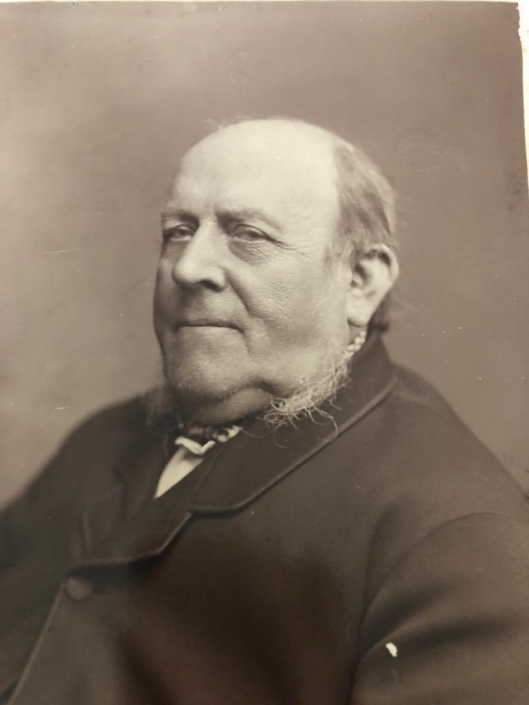
John Wood was born on the 1st February 1819 at Rastrick. He was the son of James and Hannah Wood. John was baptised at the Bethel Methodist New Connexion Chapel on the 24th February that same year, a church where he remained a member throughout his life and where, according to his obituary, ‘he filled almost every office in connection with that place.’
During his childhood, he suffered a serious accident to one of his legs which meant that he had to walk with a stick for the remainder of his days. He did not allow this impediment to interfere with his ambitions to make a success of his life.

John’s father was employed as a wool comber and by the time of the 1841 census the family had moved to what is now known as Briggate, Brighouse. John had earlier completed an apprenticeship to a local tailor and by the time of the census, he had just set up his own business in the centre of the small but developing town of Brighouse.
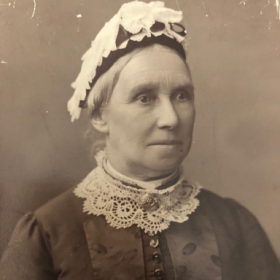
In 1844, John Wood married Ellen, daughter of John and Sarah Clayton who, like John’s parents, were members of the congregation at the Bethel Methodist New Connexion Chapel on Bethel Street. The building was the former home of the Brighouse Echo and Regent Printers and is now occupied by Yorkshire Payments. The records on ancestry.com show the wedding was in the Halifax Parish area but it wasn’t at Halifax Parish Church and I have been unable find the exact location so far. It was probably at a local Methodist Chapel but Bethel didn’t obtain a licence to carry out marriage ceremonies until 1852 therefore the search continues.
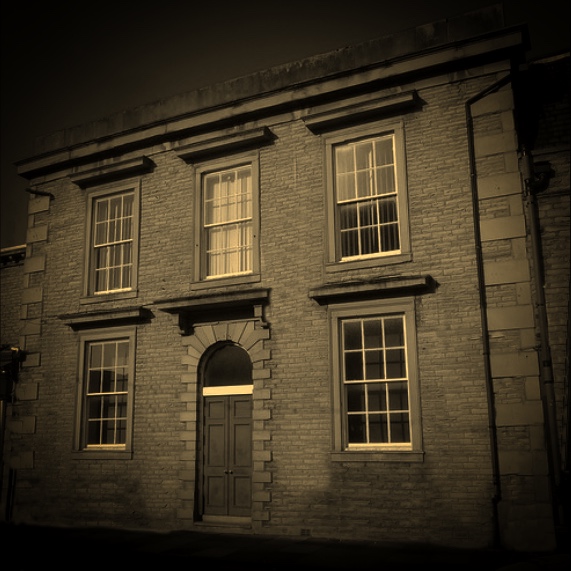
In the 1851 census, John and Ellen were still residing at Briggate, Brighouse with their two sons, Jabez (5), John James (1) and daughter Sarah (3). John was employing two Brighouse born apprentices, James Smith (15) and Brearley Denham (16) and the family had an eleven year old servant girl called Mary Mullins working in the house. They lived next door to John Hodgson who was also a tailor which led me to wonder if the two John’s were friends or whether they were keen business rivals. Their shops were positioned approximately where Wilkinson’s store is now located. John and Ellen went on to have eight children, four girls and four boys.
THE CHILDREN OF JOHN AND ELLEN WOOD
The eldest child was Jabez (1846-1900) who went on to become a self-employed plumber and plasterer working from Church Street, Brighouse.
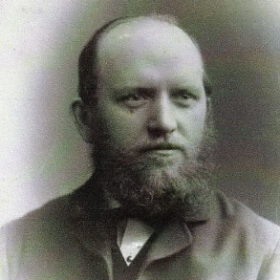
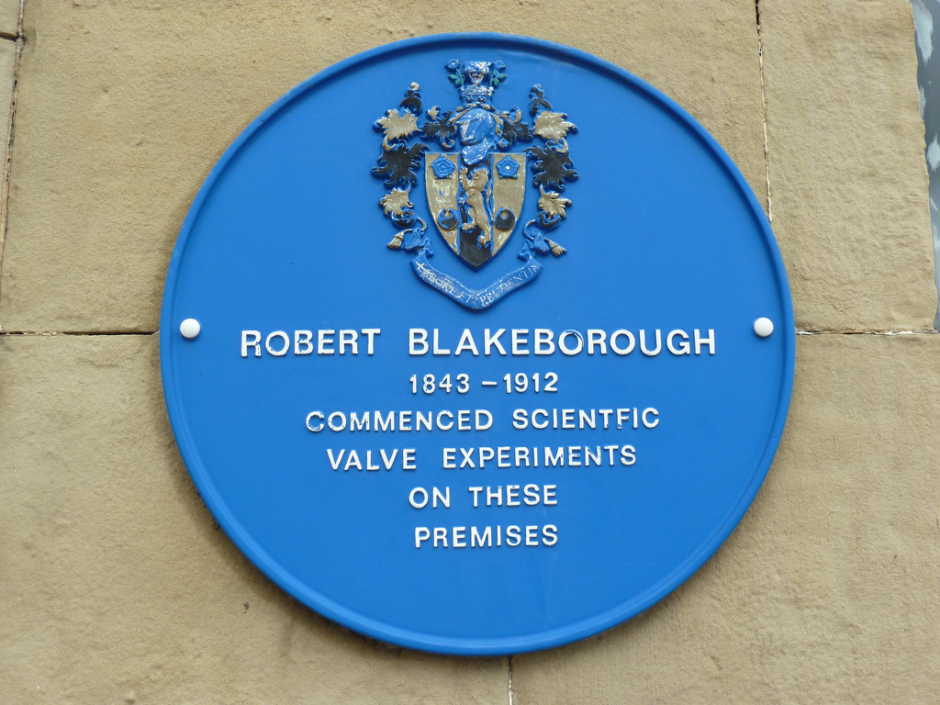
Sarah’s younger sister, Mary Ellen (1851-1941) was the fourth born child and she married the above named Thomas Blakeborough, brother of Sarah’s husband, Robert Blakeborough. Thomas was the original travelling salesman for the family firm, selling the products created by his father and brother which went a long way towards helping to shape the success of the Blakeborough name. After retirement, the couple went to live in Sturton, Lincolnshire, where Sarah died in her 90th year of age in 1941. It would appear that the two Wood girls must also take some credit for the success of J. Blakeborough & Sons Ltd with the support that they must have given to their husbands during the developmental years of the company.
The fifth born child was Samuel. He was employed as a brass finisher but died in 1871 aged just 19 years. He was unmarried.
The sixth child was another daughter, Hannah Malena who died on the 5th January 1858 aged just 2 years and 9 months whilst the eighth and final child was given a very similar name to the above young girl who died at such a young age. Annie Malena Wood was born in 1860 and is shown on the 1871 census as a scholar, living with her sister, Sarah Blakeborough and her family. By 1881, she was residing with her Aunt Hannah in Bradford where she was employed as a ‘Maid of All Work’. There does not appear to be any record of her after this date however.
I have deliberately left two of the children until last because I am going to look at them in a little more detail because it was they who helped to further progress the undertakers and cab business. These two children were the third born child, John James Wood and the seventh born, Charles Wood who I will come to shortly.
In 1862, John Wood decided to expand his tailor’s business and enter the funeral trade as an undertaker. This went hand in hand with the tailoring business as he was able to provide smart attire for gentlemen mourners to either rent or purchase. He took a lease on a new shop between the Anchor Bridge and the Black Bull Hotel. He didn’t stop there because to run a successful funeral business would require him to also provide some form of transport and so horses and carriages and a hearse were later acquired.
In the Huddersfield Chronicle dated the 28th March 1868, John was the subject of a newspaper report in the Huddersfield Chronicle where it was reported that one of his former employees, Thomas Swan Schofield had stolen two pairs of trousers and two waistcoats from his shop at Briggate.
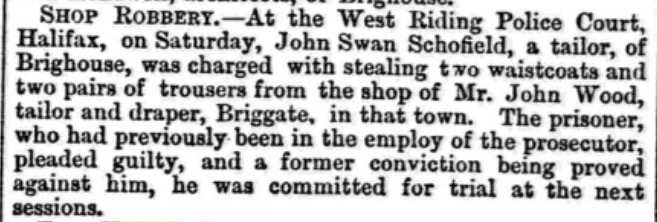
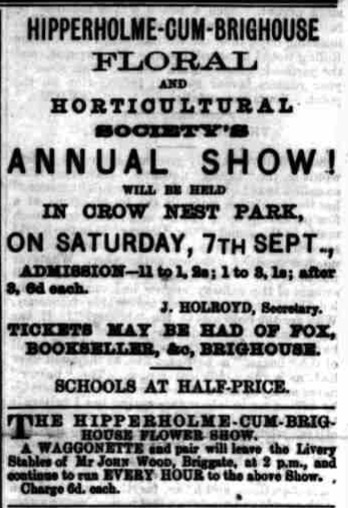
By the time of the 1871 census, John Wood and his family were residing above the tailor’s shop at 59, Briggate. This building was attached to the right of the shop that many people will remember as John Francis Brown’s and then later as Oddjobs but was demolished over 60 years ago. The census describes his employment as a tailor and undertaker.
When not in use for funerals, John would use his horses and carriages for transporting the people of the town to local events or shows such as the one shown from 1872 where he advertises that a Waggonette and Pair (of horses) will leave the Livery Stables of Mr. John Wood, Briggate at 2pm and continue to run every hour to the Hipperholme-CumBrighouse Floral and Agricultural Society Show at Crow Nest Park for a charge of sixpence per person.
In 1892, John Wood decided to retire and literally hand over the reins to his two sons, John James and Charles. Four years later, John Wood passed away aged 77 years at his home in Spring Street, Brighouse. The newspaper report stated that he had attended a service at Bethel Chapel on the Sunday afternoon but during the evening, suffered a paralytic seizure from which he didn’t recover and died two days later.
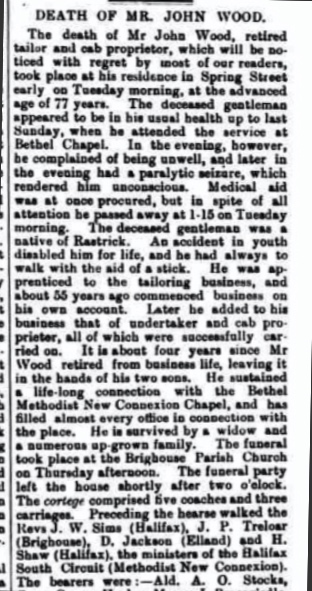
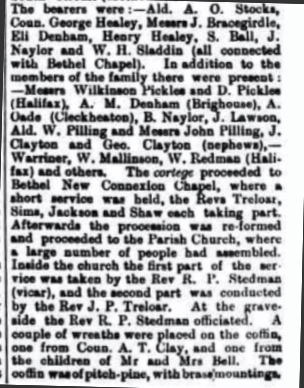
Returning to the children of John Wood, his son John James was born in October 1849. On the 1871 census he was residing with his parents at 59, Briggate where he was employed alongside his father as a tailor. On the 18th January 1872, he married twenty-year-old Annie Crowcroft from Halifax at the Parish Church of St. John the Baptist. The interesting thing is that John James’ occupation is shown as a cab driver which clearly shows that he was involved in his father’s expanding tailoring, funeral service and cab business. Following their marriage, John James and Annie moved into the house above a shop at 5, Bradford Road, Brighouse from where he continued to carry out his business as a tailor. They had five children, John Frederick (1875), Lena (1878), Charles Ernest (1879), Stanley (1883) and Annie (1891)

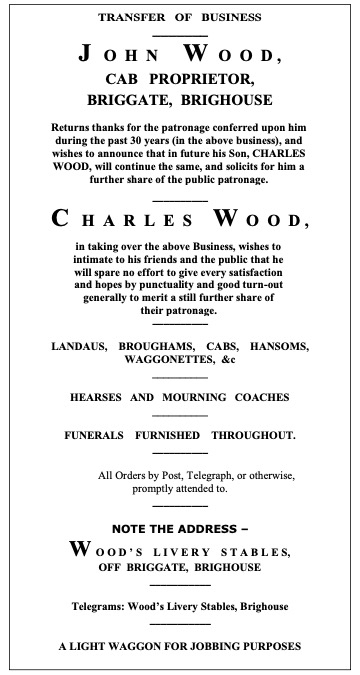
During this same period, Charles Wood, who was eight years younger than his brother John James, was also living at home with his parents and is simply shown on the 1871 census as a scholar. He eventually followed the trade of his eldest brother, Jabez and became a plumber. Charles went on to marry Emma Priestley from Brighouse in January 1882 and the couple took up residence at Bank Street, Brighouse, not far from his parent’s home at Briggate. In the 1891 census, Charles was still employed as a plumber whilst John James had moved to Spring Street where the census shows he continued to work as a tailor and draper, but things were about to change.
In early 1892, following John Wood’s decision to retire, he handed the business over to his sons, Charles and John James Wood. As already touched upon, John Wood had built up a successful tailor, funeral director and cab business. As a tailor, it followed that John James would take over that aspect of the business whilst Charles was handed the cab and funeral trade, giving up his work as a plumber. A notice was posted in the Brighouse News which ran for several weeks. It thanked the public for their trade in his cab business over the past 30 years and announced the fact that Charles has taken charge. The type of available carriages was very impressive as in addition to the funeral hearse and mourning carriage, there were landaus, broughams, cabs, hansoms and waggonettes.
TYPES OF VEHICLES ADVERTISED ON WOOD’S ADVERT IN 1872
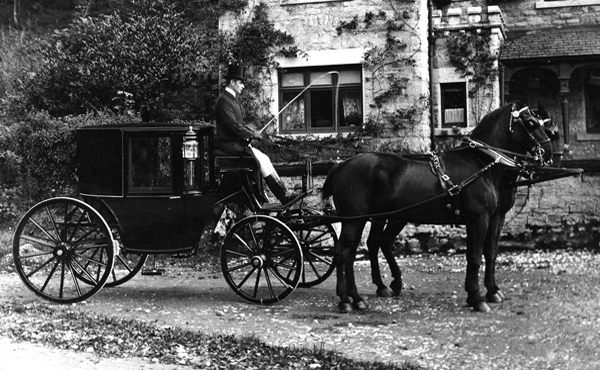
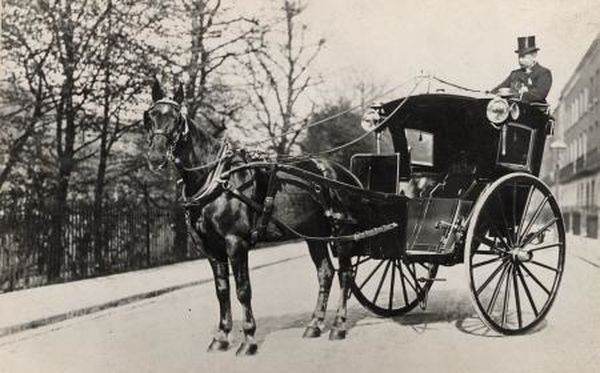
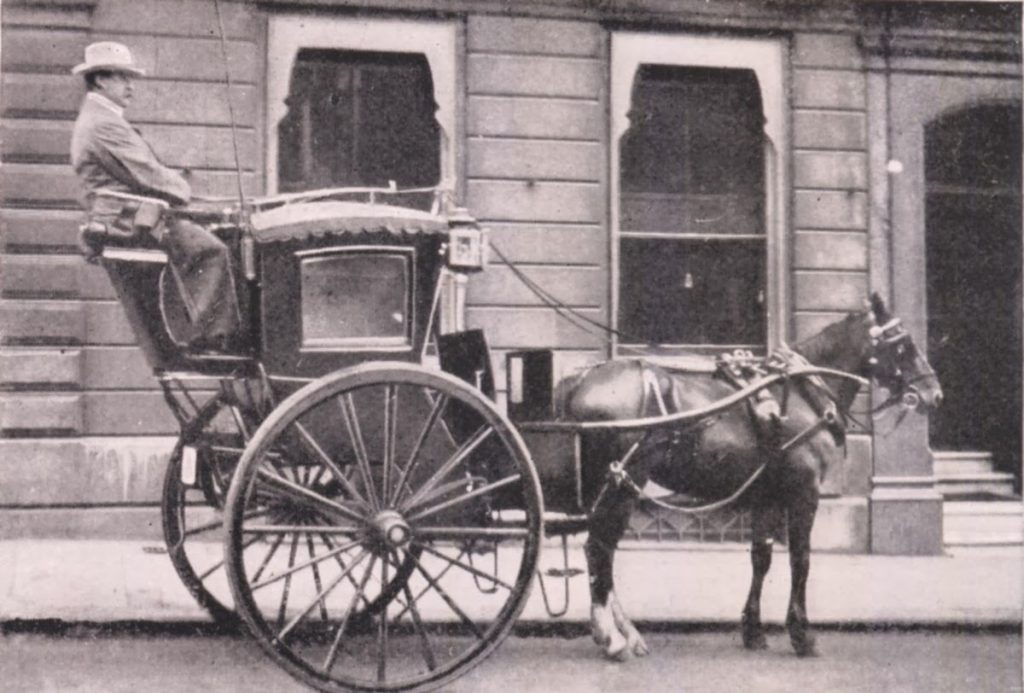

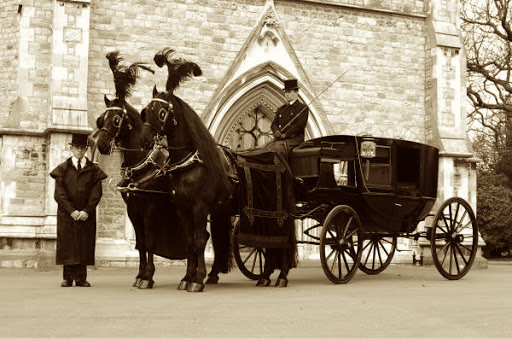
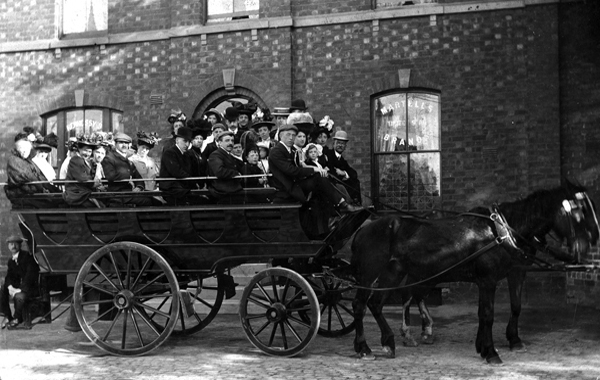
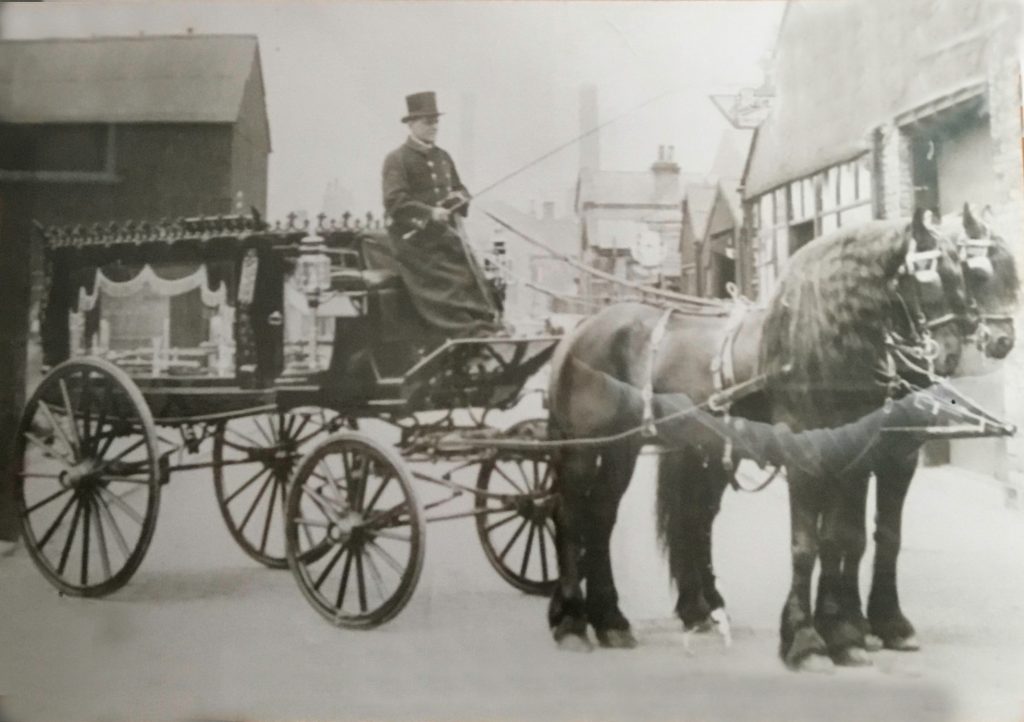
The above photograph shows one of Charles Wood’s hearses in the company livery yard. The hearse is being drawn by a pair of Belgian Blacks. Everything is magnificent. There is craftsmanship in every feature from the rubber tyres on the hearse with its shining glass panels and ornate decoration, the gleaming carriage lamps, the top-hatted driver dressed in livery to the beautifully cared for horses.
In 1895, John James Wood and his portion of the business were featured in a book entitled ‘An Illustrated Account of Halifax, Brighouse & District’, a one hundred and thirty-nine page book that furnished details of the many trades being carried out in the Brighouse and Rastrick area with an interesting synopsis of the various skills and crafts of the local workforce. From the narrative we learn that not only was John James working as a tailor and outfitter but had also acquired a posting business which presumably involved the carriage and delivery of some local parcels and post. He was also an agent for the Victoria Dyeing and Dry-Cleaning Works in Huddersfield. John James was using the cab transport owned by his brother Charles and the brothers stabled the horses and garaged the carriages in a yard off Canal Street at the rear of what is now Blakeley’s fish and chip restaurant and take-away. The shop at 59, Briggate was described as ‘a building of two storeys with an attractive frontage containing two smart show windows. The show rooms are well stocked with ready-made suits and garments in all modern styles for gentlemen and boys.’
Just to complicate the story, the house numbers on Briggate were changed in 1896. The numbers had been consecutive with odds and even numbers on the same side of the road but the new system adopted the present method whereby the odds and even numbers are on opposite sides. This meant that Wood’s shop at 59, Briggate changed to number 52.
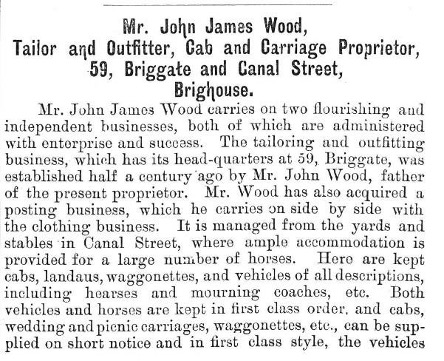
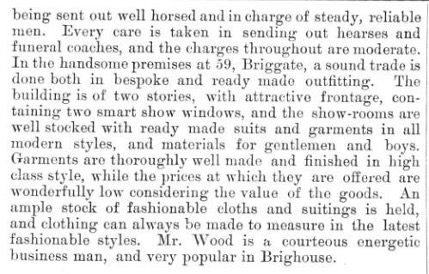
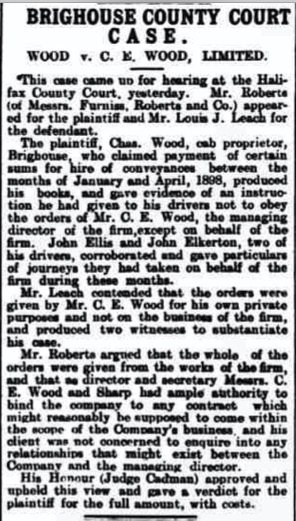
On the surface, the businesses of the Wood brothers appeared to be hugely successful but it soon became apparent that there was an underlaying current of unease and all was not as well as it seemed. In October 1899 a case was heard at Brighouse County Court where Charles Wood was claiming damages from his nephew, Charles Ernest Wood, the son of his brother, John James, on account of his deployment of the cabs for his own personal use. It appears that Charles Ernest was made managing director of the cab company despite being only 18 years of age when the alleged misuse took place between January and April 1898. This led to the company owner, Charles Wood, issuing a directive to his cab drivers not to obey any orders from Charles Ernest unless those orders were explicitly on behalf of the firm. Charles won his case and Charles Ernest was ordered to repay the amount owed plus court costs.
This led to some bad feeling within the family resulting in Charles Ernest leaving the firm and going to work as a grocer. He later became a commercial traveller in the grocery trade and eventually became a managing director once again, this time at a bakery and café in Halifax.
The family dispute appears to have led to a split in the cab business and both brothers soon commenced trading under their own respective names. In 1901, John James continued living at the Briggate shop from where he operated his tailoring business but by 1903, he is shown in another Brighouse trade directory as having removed his business to 108 Commercial Street. He is also shown as a coach and cab proprietor at the Victoria Livery Stables, Victoria Street, Brighouse with a telephone number of Brighouse 116. Victoria Street was the former name for Ship Street which adjoins Canal Street so it is probable that this is the same livery yard previously referred to behind Blakeley’s. In that same trade publication, Charles Wood is shown to have opened his own livery yard on Owler Ings Road on land to the rear of their leased shop at 52, Briggate. Charles then moved his cab business office into these premises from where his father and brother had previously run their tailor’s businesses. In the days when the telegraph was still the predominant means of communication, the forward-thinking Charles Wood became the first person to have a telephone installed in the town thus being allocated the telephone number of Brighouse 1.
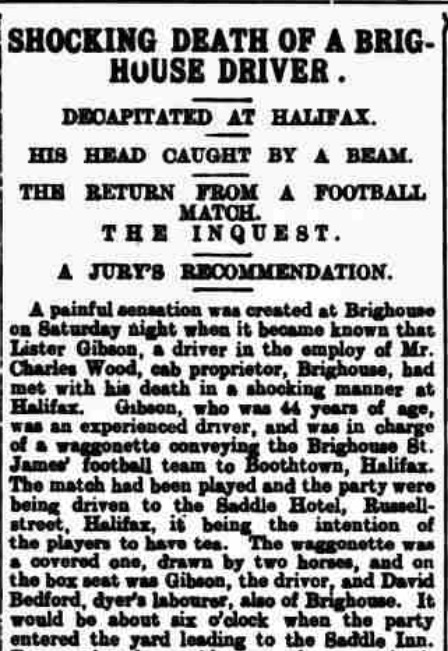
Misfortune befell Charles’ company in December 1901 when one of his drivers, Lister Gibson (44) was tragically killed whilst conveying the Brighouse St. James’ football team from their match at Boothtown to the Saddle Hotel in Halifax. The Saddle had been re-built in 1896 and formed part of the Halifax Market buildings on Russell Street in the town centre. The football team were going to the hotel for their after-match tea and were travelling in a large covered waggonette, drawn by two horses. Gibson was sat up front in the raised driver’s box along with David Bedford, one of the footballers. In order to reach the stables, the vehicle had to go through a passageway to a yard at the rear. As the vehicle entered the passage, a bystander shouted, “keep your head down.” Unknown to Lister Gibson, the height of roof decreased between the street and the rear yard and after narrowly missing the first three iron beams, Gibson’s head collided with the fourth and last beam resulting in him being almost decapitated. His body remained in the driving box with the reins still in his hands but when the carriage was reversed from the passage back towards the road into the light, Gibson’s head was described as being ‘crushed to pieces’.
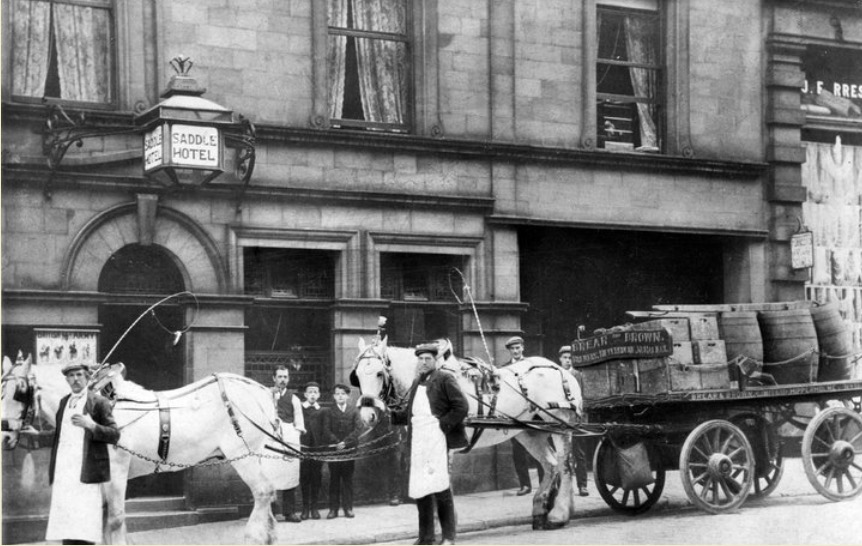
At the inquest a verdict of accidental death was recorded but the coroner added that more light should be created in the passage and that the roof should be underdrawn so that the iron girders were hidden behind a false ceiling. The following year, Sarah Gibson, the widow of the deceased, sued James Greenwood, the landlord of the Saddle Hotel. After all the evidence was heard, the innkeeper was found to have been negligent, despite the fact that the local council had approved the plans for the building which included the sloping roadway inside the passage. Sarah told the court at Leeds Assizes that her husband was a fit man and was expected to live for many more years. He was earning £1 per week whilst employed by Charles Wood and due to his death, she was deprived of her only support. Sarah was awarded £100 damages for her loss !
JOHN JAMES WOOD EMIGRATES TO CANADA
No-one in the present family of Wood descendants appears to know anything about what happened next but in 1907 John James Wood decided that he had enough of Brighouse and emigrated to Canada. At 57 years of age it probably seems a somewhat strange decision as one would have thought that he would be looking forward to retirement rather than making a new life for himself several thousand miles away, but he sailed off with his wife and his 15 year old daughter, Annie, never to return to England. The three of them departed Liverpool on the 26th April 1907 on the Allan Line ship named Virginian, bound for Montreal.
The photograph below is an excerpt from the passenger log book of the Virginian showing Mr. J. James Wood with his wife and daughter, both named Annie
They eventually made a home in Winnipeg, Manitoba where in 1916, John James, at the age of 67 years, was once again working as a tailor at 315, Balmoral Street, an area that is now mainly student occupied due to its proximity to the University of Winnipeg.

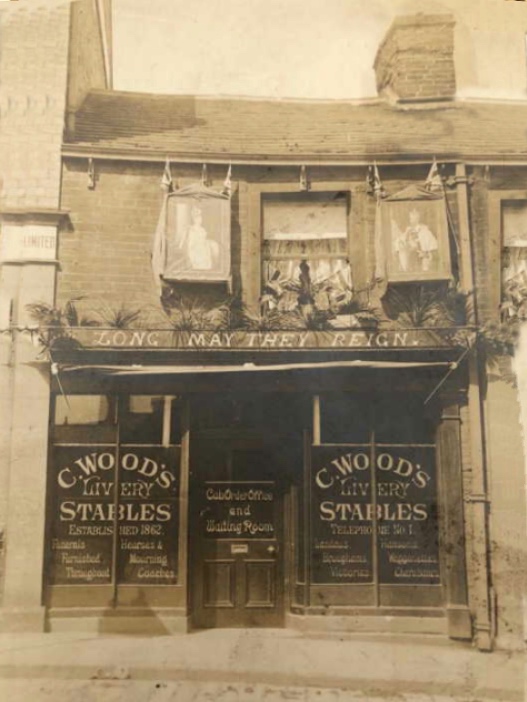
The Briggate premises are shown in this photograph above taken in 1910 when the front of the shop was decorated to celebrate the coronation of King George V and Queen Mary. The door clearly shows that the former tailor’s shop was now the cab order office and waiting room whilst the windows give information about the cab types, date of establishment in 1862 and the telephone number of Brighouse 1. A tax return for that same year (shown below) shows that Charles Wood leased the premises from the estate of Lady Piggott via Barber & Jessop Solicitors of Church Lane, Brighouse. They included the shop at no. 52, a small old house to the rear which had been allocated the number 60 and the stables and garages also to the rear, with access via Owler Ings Road.
It is interesting to note that John Francis Brown occupied the building and house next door at number 54 but he only leased one third of that building which he took over in its entirety in later years. The double fronted section at 56-58 was the drapers shop belonging to John Tate.
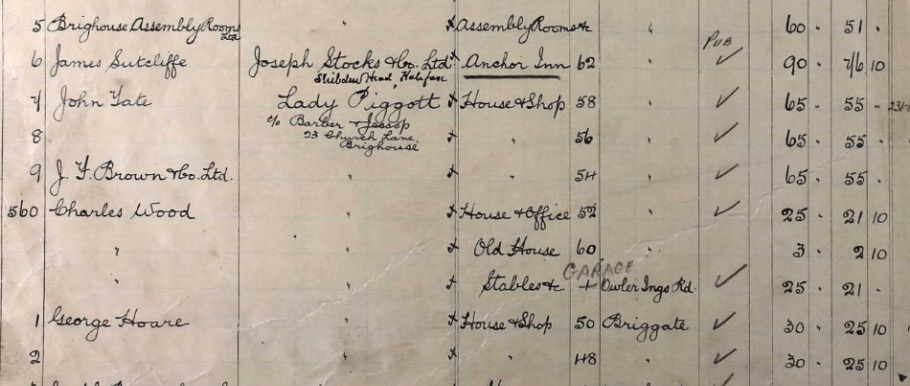
In the 1911 census, Charles Wood is shown as residing at 52, Briggate with his wife and six of their seven children. The missing person was his eldest son, Samuel Sutcliffe Wood who had studied at Dundee University and was working in Portsmouth as a civil engineer, builder and contractor. It was apparent that he was making his own way in life and would not be interested in running the cab business. In fact, the only one of his children who was working for the company was his second son, John. He was employed as a saddler but as motor vehicles became more prevalent on the roads, there were over 100,000 in 1910, the need for people of his profession was diminishing rapidly. Charles’ other two sons, Charles Henry and Thomas had reasonably good jobs at Blakeborough Valves and showed no interest in taking over the family business and so it was sold in 1920. Charles Wood passed away on the 22nd April 1928, amazingly, within just four hours of his wife Emma.
Information regarding what happened to the company following the retirement of Charles Wood has now come to light. This has been kindly provided by Rosemary Evans, the great grand-daughter of Charles and Emma Wood and grand-daughter of their daughter, Lucy Wood. She married Norman Marmaduke Pilling who presided over the centenary dinner celebrations of the company in 1962 at the Brighouse Assembly Rooms. Rosemary discovered the notes from his speech on that evening along with other interesting items relating to the company and it is from these articles that we can complete the story.
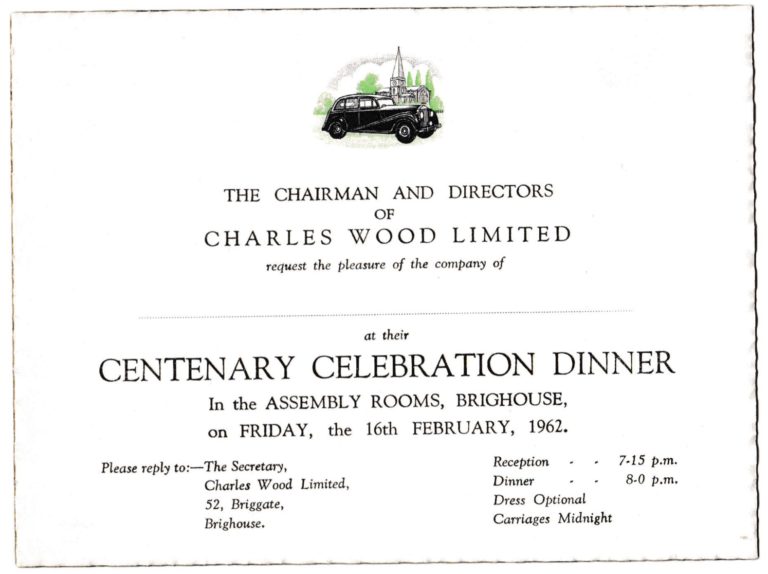
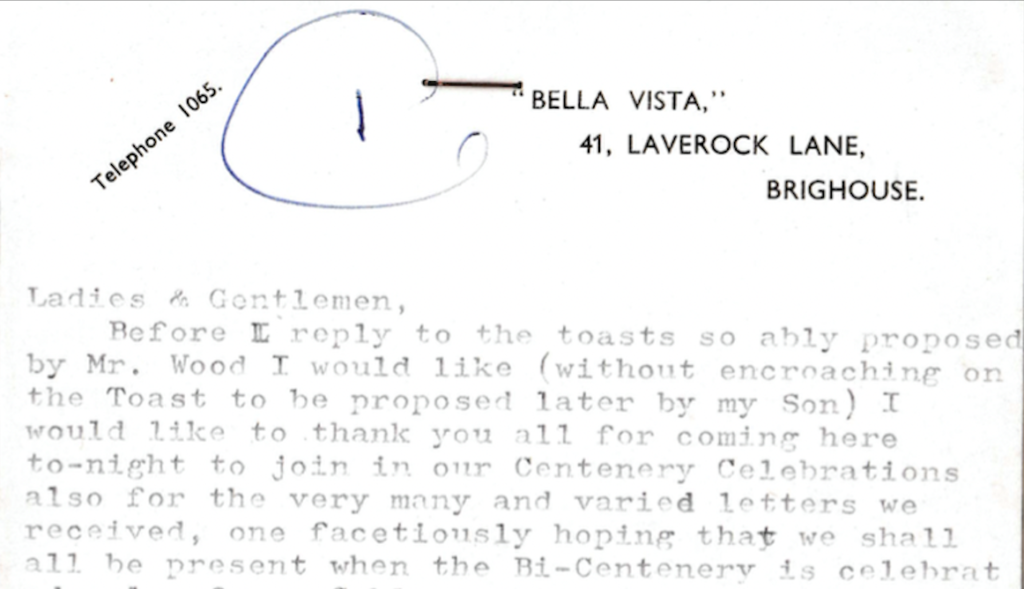
Written on letter headed notepaper for BELLA VISTA, 41 LAVEROCK LANE, BRIGHOUSE, Norman Pilling wrote about receiving a Cablegram from New Zealand signed by ‘The Bugler.’ He said that this name came into being many years ago when his nephew, Teddy Wood was a small boy. Teddy was playing in the coach house and found a bugle that was used in the old days by the Step Boy on the waggonettes. The boys grandfather, Mr. Charles Wood, gave it to him and he had treasured it since, taking it to the many countries where he worked for the government in the Colonial Office, including New Zealand where he was now settled.
Norman Pilling remarked upon how John Wood had retired in 1889 and sent for his son, Charles, to take over the company. Charles was a plumber having been brought up by the old Birds Royd firm of T. W. Helliwell, plumber & glazier and at that time was the village plumber employed by the Ingleby family of Ripley Castle near Harrogate. After accepting his father’s invitation, he returned to Brighouse and settled at Marion Street with his wife and two boys. They later moved into a house at Bank Street to be nearer to the business where four more children were born. In 1901, Charles Wood moved into the house behind and above the Briggate office. The telephone was just arriving in the town and prior to having it installed, the communication between the office and the stables was by means of a ‘speaking tube.’ The telephone was a great advance in assisting the hire trade and Charles, being one of the first batch of applicants, was allotted Number One.
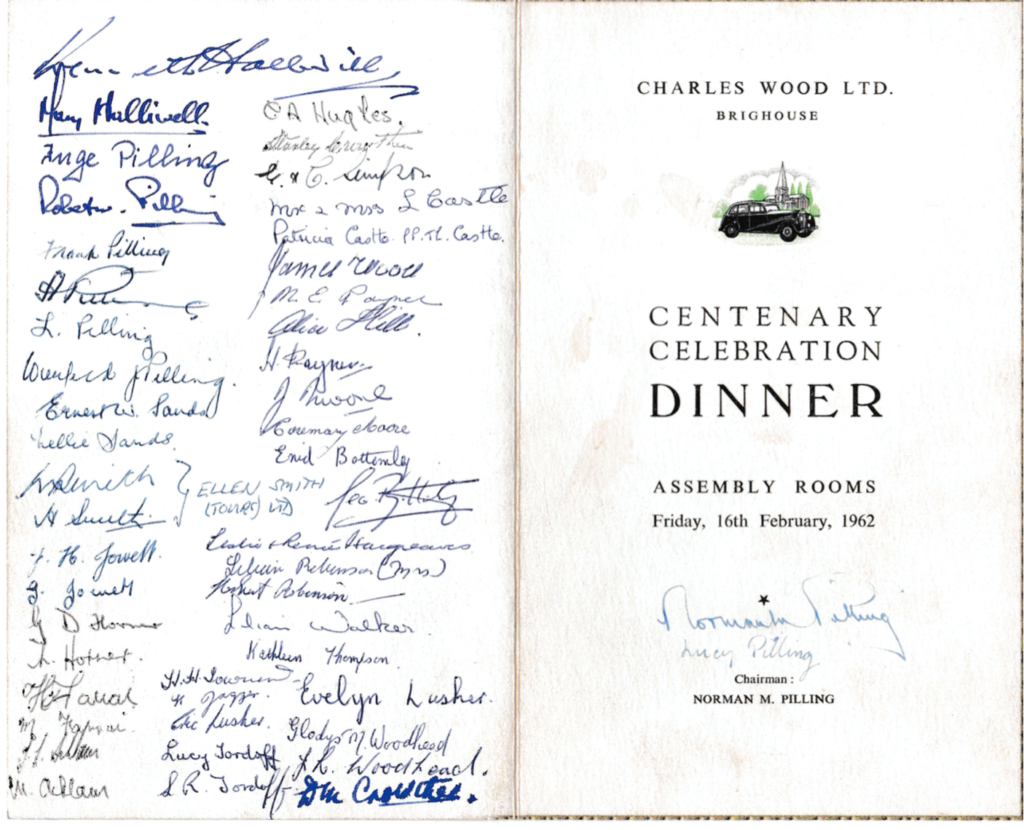
With the advent of the motor car, Charles Wood bought a taxi shortly before the 1st WW. This proved to be an expensive move for in those days, cars spent a large proportion of their time undergoing repairs. He struggled through the war period with its general shortages, particularly of labour and in 1920, he felt that he had had enough.
Norman Pilling said, “it was at this time that I came onto the scene.” Having returned from active service in the 1st WW in 1919, he returned to his former trade in pharmacy where he had served an apprenticeship but he could not settle back into that trade. In July 1920, he and his father formed the Brighouse Taxi Company at a small coach house in Parsonage Lane. Their first customer was Richard Sugden, head of the flour-milling company who gave Norman one shilling an hour in addition to the taxi fare. That same year, he discovered that Charles Wood was selling his business and after consulting with his father, the Pillings decided to buy the business and formed it into a limited company called Charles Wood Ltd. With his father as chairman and himself as manager. He said, ‘it was all new and strange to me but Mr. Wood was kindness itself and gave me all the advice and information that he could. Then came the big turning point in my career.” He explained that Charles Wood’s daughter, Lucy Wood, looked after the office work whilst he was driving the horses or cars. Something more than a business relationship developed as Norman and Lucy were married in February 1922. In 1924, they took over the carriage business of the late William Crowther, whose son Arthur joined Charles Wood Ltd. As the reliability of motor vehicles improved, the company bought more motor cars and hearses. In 1926, they bought their first motor coach, a Lancia which in those days was considered to be the Rolls Royce of coaching. A second coach was purchased in 1930.
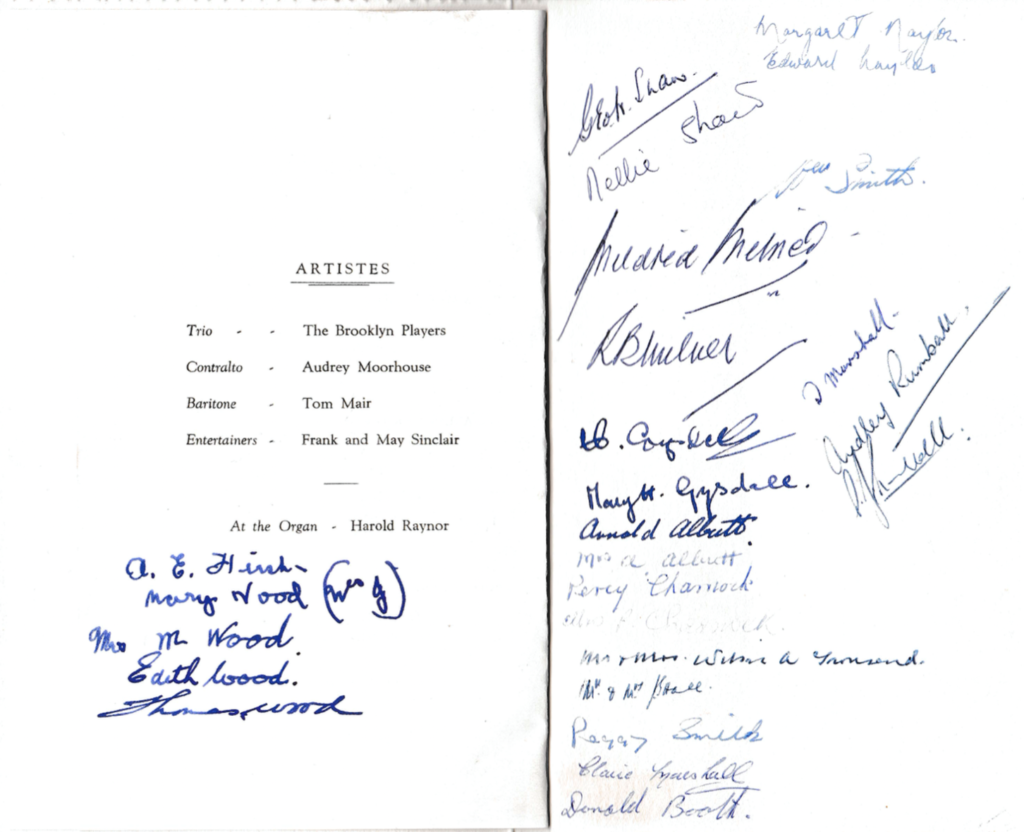
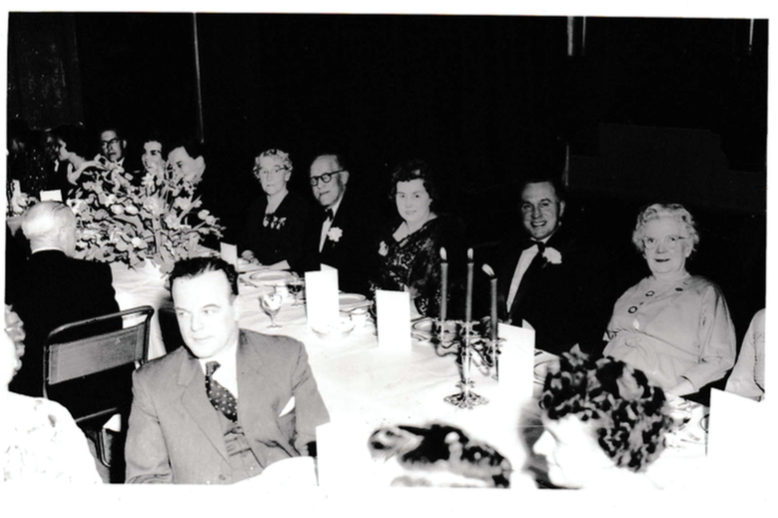
In 1938, Charles Wood Ltd made the decision to go ‘fully motorised’ and sell off their horses and other equine effects. An article appeared in the Brighouse Echo at the time which read as follows: –
Times change and with them it becomes a platitude to say that the day of the horse is over. Whether that statement is general or not, today does mark the closing of an epoch as far as Brighouse is concerned, for today is the occasion of the sale of the horses and gear of Messrs. C. Wood, of Brighouse, who are turning over entirely to motor transport.
The firm was established in 1862 and continually since that time horses have been kept at the Owler Ings Road stables for coach and haulage work. The firm was not founded by Charles Wood, whose name it bears, but by his father, who combined the business of tailor at the front of the premises and coach owner at the back. At one time over twenty horses were kept in the stables but the number of the remaining ones to be sold today is only six.
The firm have a very long connection, therefore, with livery work and before the introduction of bus and tram services they ran a waggonette service between Rastrick and Brighouse. This was carried on in the early 1900’s and the service was known as the ‘10:30 down express.’ The horses which drew the fire engines were also stabled at Owler Ings and were used for ordinary coach work when a motor engine was introduced.
One of the fire engine horses never forgot his duties with the brigade and he apparently did not enjoy attending a fire. It is not easy to say whether it was the speed required or the heat of the fires, but when that horse was released from engine duty it would never go up John King – to, it is thought, the fire station again. It would turn back and refuse to mount that particular rise.
During the war, many horses were commandeered for military service and several went from Messrs. Wood’s stables. The tale went round that the horses had been sent back as unsuitable and a reporter came to interview the proprietor as to the reason. He had been leg-pulled, however, for the source of the story was the anecdote which went round the town that none of ‘Charlie Wood’s horses’ would start until they heard a cab door shut. It is alleged that a cavalryman had to clap two pieces of wood before the horses would move off.
One of the most unusual horses was Frank, who died only three or four years ago. He was very fond of a glass of beer and would make short work of a pint. On one occasion, he disgraced himself whilst Mrs. John Thornton was using one of the cabs for shopping in Halifax. Frank calmly turned his head and lifted off the hat of a lady passer-by in his mouth.
The last opportunity on which Brighouse folks had the sight of a waggonette in action was in May 1926, during the General Strike. On that occasion Messrs. Wood’s turned out a temporary service between the George Corner and Bailiff Bridge.
But today, two black stallions and four black geldings come under the auctioneer’s hammer, as it were, together with the whole of the horse-drawn vehicles and equine equipment. Perhaps the two who will feel it most will be the two coachmen, Mr. William Welch and Mr. A. Crowther. Mr. Welch has been at the stables since a boy.
The familiar black coaches and hearses will not be seen at funerals anymore, nor will the landaus be brought into commission on Rush Saturday. Time marches on.
The Second World War started the following year and brought further difficulties due to petrol rationing and a general shortage of most things, particularly tyres. Perhaps the company rued the decision to dispose of the horses and carriages.
Mr & Mrs Pilling continued to live at 52 Briggate until 1955 when they moved to Laverock Lane. A co-director, William Smith and his wife took over some of the responsibilities from Mr. Pilling and they ran the business until Mr. Pilling sold the company in 1964.
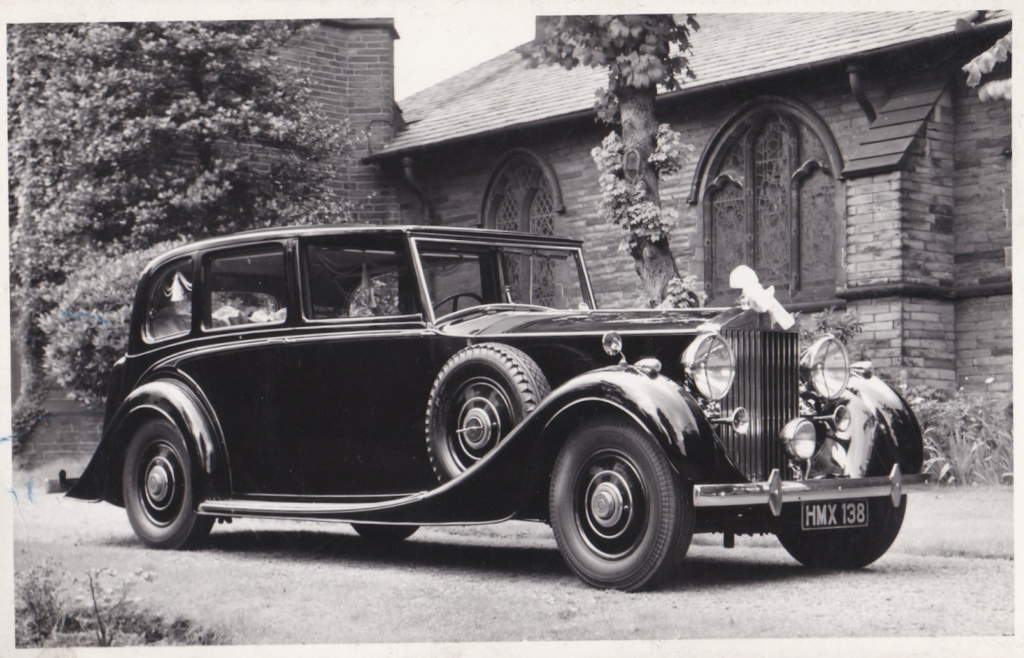
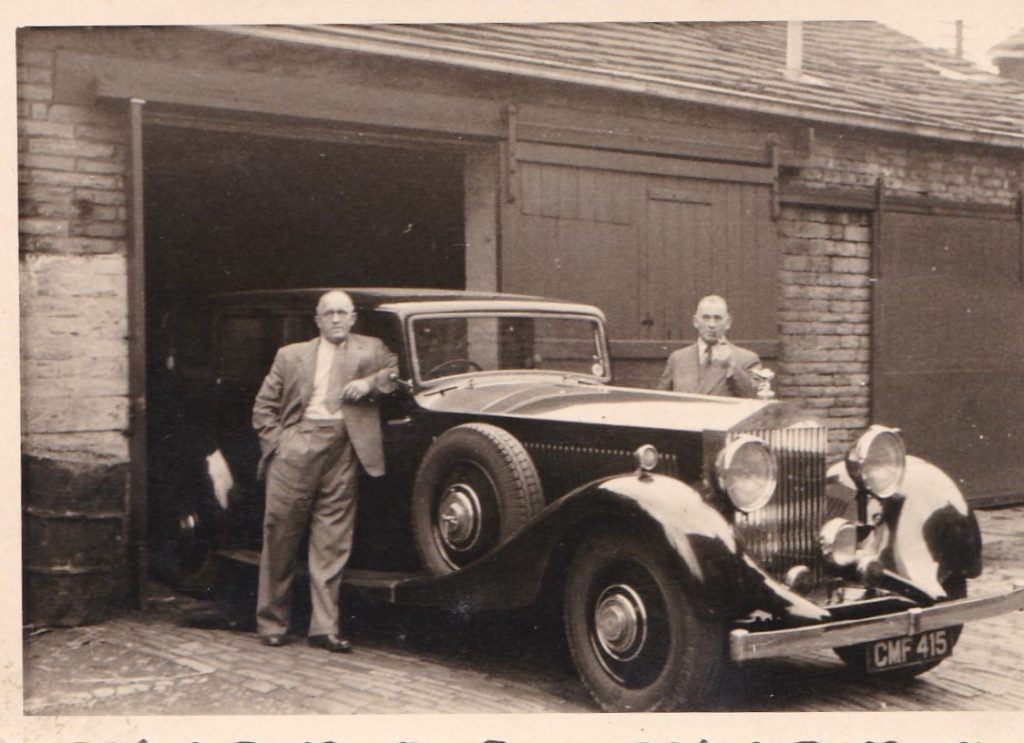
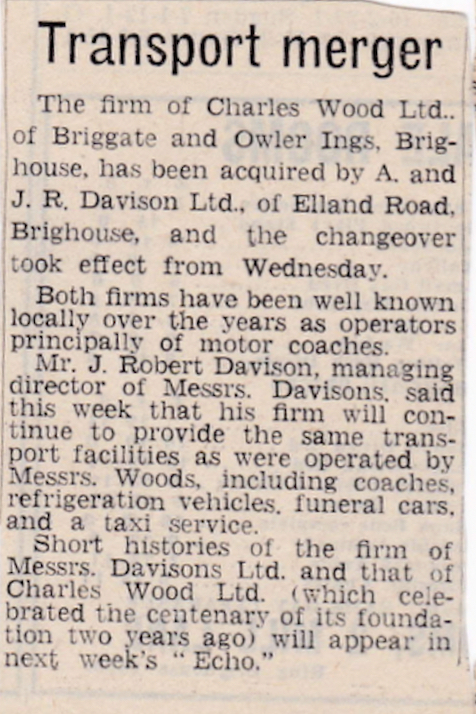
The business continued with the name of Charles Wood, which had become a well respected name in the cab and funeral business. The purchaser was a company that started in Brighouse in 1919 on Water Street at the back of Blakeborough’s Club and progressed from owning horse drawn carts to buying a motor lorry and hauling coal for the Co-op. They went on to take over the former Charles Wood livery stables and build a garage for their motor coaches. That company was A & J.R. Davison, who many will also fondly remember as a coach company. The new owner stated that his firm would continue to provide the same transport facilities as were operated by Messrs. Wood including coaches, refrigeration vehicles, funeral cars and taxi service. The merger meant that the new company could provide taxi’s to bring the customers down to the coach station before embarking on their day trips.
The funeral service was later sold as it was of no interest to the new purchaser and that went to another company. As a coach firm, Davisons had purchased a fine 20 seater Centaur Sun Saloon, pictured below, in 1929 and was the height of luxury at the time.
The company name of Charles Wood has changed hands on several occasions for both the taxi and funeral companies. The latter is now owned by Dignity Funerals Ltd of Sutton Coldfield in the West Midlands though a local chapel of rest is available to customers at the former St John Ambulance Brigade HQ at Bramston Street, Rastrick. The private hire company is known as Woods Taxis Ltd with its head office at 2, Market Street, Brighouse, the current owner being Mr. Mohammed Iqbal.
Thanks for the family photographs go to Lesley Drake and Linda Harford who are descendants of Stanley Wood, the grandson of Charles Wood and to Becky Sheard who has also researched the Wood family tree and provided me with the above contacts. Also to the aforementioned Rosemary Evans for allowing me access to her family memorabilia and giving permission to use it here.
